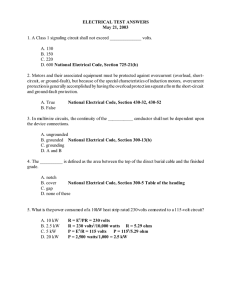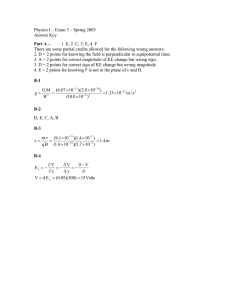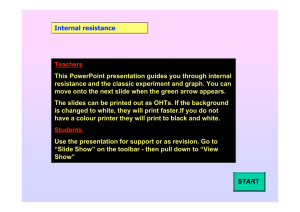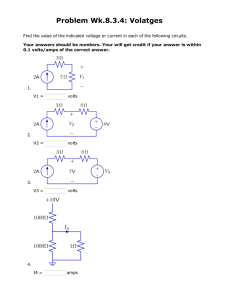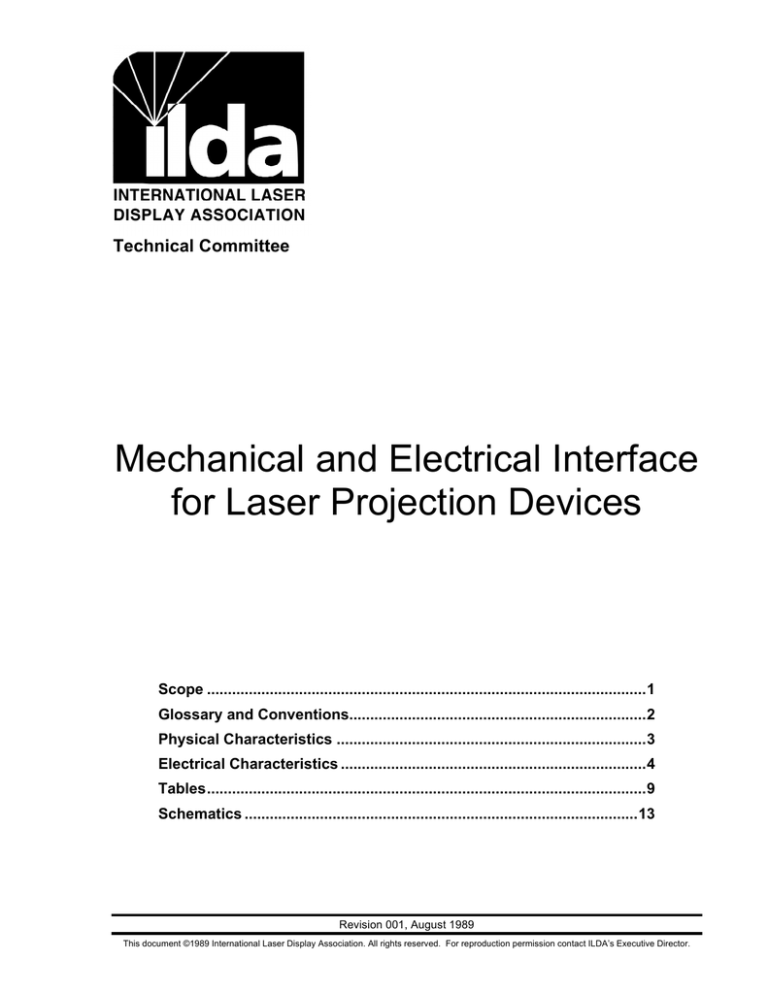
Technical Committee
Mechanical and Electrical Interface
for Laser Projection Devices
Scope ......................................................................................................... 1
Glossary and Conventions....................................................................... 2
Physical Characteristics .......................................................................... 3
Electrical Characteristics ......................................................................... 4
Tables ......................................................................................................... 9
Schematics .............................................................................................. 13
Revision 001, August 1989
This document ©1989 International Laser Display Association. All rights reserved. For reproduction permission contact ILDA’s Executive Director.
Mechanical and Electrical Interface
ILDA Technical Committee
Revision 001, August 1989
This document ©1989 International Laser Display Association. All rights reserved. For reproduction permission contact ILDA’s Executive Director.
ILDA Technical Committee
Mechanical and Electrical Interface
Scope
This Laser Projector Interface Standard provides the cable, mechanical
and electrical requirements for interfacing with laser projection systems.
The primary objective of this standard is to define a mechanical and
electrical interface for laser projection devices so as to provide laser
graphic playback systems, within a certain class of laser projectors, with
device independence. A secondary objective is to allow for remote
projector operation over a single cable at distances of several hundred feet.
Thus, laser projectors with either single or dual scanner sets, full-color or
monocolor outputs, differential or single-ended wiring, local or remote
operation can all be easily accommodated by this standard.
Provisions have been made for future asynchronous digital
communications between laser projection devices and laser graphics
playback systems.
A laser safety provision has been included by defining a Master Shutter
control line for each scanner set within a projection device.
To accommodate precise long distance remote operation, we have defined
a differential driver/receiver configuration for the projector interface
standard. For applications where single-ended driver configurations are
currently used, we have incorporated a single-ended driver option into this
standard.
Although individually shielded twisted pair wire has been specified for the
interfacing standard, readers should understand that cabling trade-offs may
be required to achieve satisfactory system operation and cost.
Revision 001, August 1989
Page 1
This document ©1989 International Laser Display Association. All rights reserved. For reproduction permission contact ILDA’s Executive Director.
Mechanical and Electrical Interface
ILDA Technical Committee
Glossary and Conventions
Glossary
•
Noninverting Signal (+). The “true” sense of a signal definition. This
signal will be denoted by a (+) symbol placed immediately after a
signal name.
•
Inverting Signal (-). A signal which is a mirror-image of a
noninverting signal. This signal will be denoted by a (-) symbol placed
immediately after a signal name.
•
Differential Voltage. The potential difference measured between the
noninverting and inverting signal lines as defined by the following
equation.
•
Single-ended Voltage.
VDIF = V(+) - V(-)
The potential difference as measured between a signal and its
reference ground potential.
•
Common-mode Voltage. VCOM = V(+) + V(-)
The average potential difference measured between the noninverting
and inverting signal lines.
•
The word “shall” indicates a requirement that must be met to comply
with the standard.
•
The word “recommended” marks specifications which, while not
mandatory, will provide the best performance.
•
The word “suggestion” denotes specifications which will ensure full
compatibility and stay within the spirit of the standard.
•
The term “reserved” is used for signals that are set aside for future
standardization.
Conventions
Page 2
Revision 001, August 1989
This document ©1989 International Laser Display Association. All rights reserved. For reproduction permission contact ILDA’s Executive Director.
ILDA Technical Committee
Mechanical and Electrical Interface
Physical Characteristics
Connector Requirements
The interface connection at each projection device shall be a 37 Pin
Circular Plastic Connector (CPC) type, Reverse Sex (with Socket
Contacts), Square Flange Receptacle with a Series 1 Contact
Arrangement. See Table 2 for recommended manufacturers.
Cable Requirements
The recommended connecting cable between the projection devices and
the graphic playback systems is individually shielded twisted wire pairs;
however, this may vary depending upon projector design and cable length
required. See Table 1 for Recommended Cable Types. Implementations
may require trade-offs between shielding effectiveness, cable length and
the number of conductors to achieve satisfactory system operation. For
short cable lengths, unshielded twisted pair wires may be acceptable.
Single/Dual Scanner Sets
For projection devices having only a single scanner set, the top portion of
the standard receptacle shall be used. The lower portion of this receptacle
shall be reserved for the second set of a dual scanner set device.
Connector Pinouts
The interfacing connector pinouts have been defined for single-ended or
differential sources, driving single or dual scanner set projection devices.
Revision 001, August 1989
Page 3
This document ©1989 International Laser Display Association. All rights reserved. For reproduction permission contact ILDA’s Executive Director.
Mechanical and Electrical Interface
ILDA Technical Committee
Electrical Characteristics
Five differential analog signals (Red, Green, Blue, X-Axis, Y-Axis) and
one single-ended digital signal (Master Shutter) have been defined for a
full color, single scanner set laser graphic image. The differential analog
signals are defined in terms of a noninverting (+) and the inverting (-)
signal lines. Additional signals, TX and RX, have been defined for future
digital control options.
Signal Definitions
Red (+)(-)
Used in full color RGB projection systems, this signal controls the Red
intensity of the color mix. In monochrome projection systems, it shall
control the beam blanking and intensity levels. This signal shall be a
Unipolar analog signal whose differential voltage ranges from 0 volts to
+10 volts. 0 volts shall denote maximum black level (full OFF) and +10
volts shall denote maximum white level (full ON).
Green (+)(-)
Used in full color RGB projection systems only. This signal controls the
Green intensity of the color mix. It is a Unipolar signal whose differential
voltage ranges from 0 volts to +10 volts. 0 volts shall denote maximum
black level (full OFF) and +10 volts shall denote maximum white level
(full ON).
Blue (+)(-)
Used in full color RGB projection systems only. This signal controls the
Blue intensity of the color mix. It is a Unipolar signal whose differential
voltage ranges from 0 volts to +10 volts. 0 volts shall denote maximum
black level (full OFF) and +10 volts shall denote maximum white level
(full ON).
X-Axis (+)(-)
Controls the X axis beam position. It is a Bipolar signal whose differential
voltage ranges from +10 volts to -10 volts. A +10 volt level shall
Page 4
Revision 001, August 1989
This document ©1989 International Laser Display Association. All rights reserved. For reproduction permission contact ILDA’s Executive Director.
ILDA Technical Committee
Mechanical and Electrical Interface
correspond to a maximum positive X-Axis deflection and a -10 volt level
shall be a maximum negative deflection. A 0 volt level corresponds to the
image's X-Axis center point. A positive X-axis deflection is defined for
front projection viewing and shall be defined as beam movement to the
right.
Y-Axis (+)(-)
Controls the Y axis beam position. It is a Bipolar input signal whose
differential voltage ranges from +10 volts to -10 volts. A +10 volt level
shall correspond to a maximum positive Y-Axis deflection, and a -10 volt
level shall be a maximum negative deflection. A 0 volt level corresponds
to the image's Y-Axis center point. A positive Y-axis deflection shall be
defined as a beam movement upward.
Master Shutter
Controls the laser beam output of individual scanner sets. It is a Unipolar
single-ended digital signal whose voltage levels are 0 volts and 5 volts. 0
volts shall disable the laser beam output and +5 volts shall enable it. An
open-circuit “floating” line condition shall default to 0 volt input level,
thus disabling the laser beam output.
Serial TX (+)(-)
An asynchronous serial transmit line used for transmitting digital
information to a laser projection device. Currently reserved for future laser
projector control functions.
Serial RX (+)(-)
An asynchronous serial receiving line used for receiving digital
information from a laser projection device. Currently reserved for future
laser projector control functions.
Blanking
For systems which process blanking signals separately from color levels, a
blank signal (full beam OFF) shall be defined as the logical OR of color
signals Red, Green, and Blue.
Revision 001, August 1989
Page 5
This document ©1989 International Laser Display Association. All rights reserved. For reproduction permission contact ILDA’s Executive Director.
Mechanical and Electrical Interface
ILDA Technical Committee
Monochrome Projection Systems
A monochrome graphic generator shall drive the Red color lines at least,
but it is suggested that all three (R,G,B) color signals be driven to allow
playback on a color projection system.
A monochrome laser projector shall receive at least the Red color signal. It
is suggested, however, that it respond to all three color signals for
compatibility with color graphic generators.
Line Driver Specifications
Analog Differential Line Drivers
Each of the two differential line drivers shall develop +/- 5 volts
corresponding to differential voltage levels of 0 volts to +/- 10 volts into a
balanced 10k ohm load. The common-mode voltage levels shall be +/- 5
volts maximum.
Note: A common-mode voltage level of 0 volts is recommended.
The source impedance shall be less than 1000 ohms; however, we
recommend that the source impedance be between 100 and 150 ohms. The
driver circuitry shall be capable of driving a capacitive load of 0.1
microfarads (equivalent to approx. 1000 feet of cable) without instability.
The driver circuitry shall be current-limited to 100mA or less and shall
tolerate a short, or any potential within +/- 10 volts, to ground.
Analog Single-ended Line Drivers
A single-ended driving source shall be capable of generating voltage
levels of +/- 10 volts into a 10k ohm load. This signal shall have no
common-mode potential and shall be applied to the noninverting (+)
signal lines. The inverting (-) signal lines shall be connected to ground
reference at the driver side.
The source impedance shall be less than 1000 ohms; however, we
recommend that the source impedance be between 100 and 150 ohms. The
driver circuitry shall be capable of driving a capacitive load of 0.1
microfarads (equivalent to approx. 1000 feet of cable) without instability.
The driver circuitry shall be current-limited to 100mA or less and shall
tolerate a short, or any potential within +/- 10 volts, to ground.
Page 6
Revision 001, August 1989
This document ©1989 International Laser Display Association. All rights reserved. For reproduction permission contact ILDA’s Executive Director.
ILDA Technical Committee
Mechanical and Electrical Interface
Digital Master Shutter Drivers
The shutter driver shall develop 0 volts and 5 volts as defined in “Signal
Definitions: Y-Axis (+)(-)” section.
The driver shall have a source impedance less than 1000 ohms. We
recommend that this source impedance be between 100 and 150 ohms.
The driver circuitry shall be current-limited to 100mA or less and shall
tolerate a short to ground or any potential within +/- 10 volts to ground.
Line Receiver Specifications
Analog Differential Line Receiver Specifications
The line receivers shall be balanced differential input. The noninverting
input shall be arranged to drive the output device in the proper true
direction as defined in Section 4.1. The inverting input shall drive it in the
opposite direction.
The line receiver shall accept a signal of at least +/- 10 volts differential
and shall tolerate a common-mode voltage of at least +/- 5 volts. The
common-mode rejection of the receiver is not specified, but for noise
rejection, it is recommended that the circuit be implemented with 1% or
better resistors.
The balanced input impedance shall be no less than 10k ohms due to
loading considerations. The maximum input impedance is not specified in
this document.
Analog Single-ended Line Receiver Specifications
For short-haul applications and for applications where limited noise
immunity is acceptable, the standard will accommodate a single-ended
line receiver. We do not recommend a single-ended line receiver for
applications using signal cable runs over 25 feet, nor for applications using
equipment from multiple vendors.
The single-ended line receiver shall be designed to accommodate a drive
voltage of +/- 10 volts. Because the drive circuitry may supply either +/- 5
volts or +/- 10 volts, depending on type, the line receiver must include a
means of adjusting the gain to accept +/- 5 and +/- 10 volt full-scale
inputs. A variable gain control to compensate for variations in source
voltage levels and line loading effects is recommended but not required.
Revision 001, August 1989
Page 7
This document ©1989 International Laser Display Association. All rights reserved. For reproduction permission contact ILDA’s Executive Director.
Mechanical and Electrical Interface
ILDA Technical Committee
The single-ended line receiver shall be connected to the noninverting
signal line, and the inverting signal line shall not be connected. Since the
line may be driven by a differential driver, it must not be grounded. The
input impedance of the receiver shall be no less than 10k ohms due to
loading considerations. The maximum input impedance is not specified in
this document.
Digital Line Receiver Specifications
The Master Shutter digital receiver must respond to a digital control signal
of 0 and 5 volts. The switching threshold is not specified, but for
maximum noise immunity, it should be approximately 2.5 volts with 0.5
volts hystereses. The line receiver shall be able to tolerate a signal swing
of at least +/- 10 volts without damage.
The load impedance shall be at least 5k ohms, but we recommend that the
load impedance be between 5k and 10k ohms.
Note: A TTL input circuit will NOT satisfy the requirements of this
section. (The input will not be able to withstand input voltages of +/- 10
volts.) Suggested input circuits include CMOS or Op Amp comparator
inputs with suitable pull-down and input limiting resistors as well as RS232 line receiver inputs (1489).
Serial Interface Definitions
The TX and RX Serial Interface wire pairs have been defined for future as
asynchronous digital communications between a Host controller and a
laser projection device. The electrical characteristics of this interface shall
be defined by EIA Standard RS-422-A, December 1978.
These lines are currently reserved (not for use) pending future
specification of the data format, control codes and other details of the
interface.
Spare Signal Lines
The spare signal lines are undefined and may be used for any analog or
digital signal communication in either direction. Since the functionality is
undefined and signals may be present, any equipment receiving data from
these lines shall have the capability of being disconnected from them.
The spare signal driver may apply any signal not to exceed +/- 10 volts.
The driver circuitry shall be current-limited to 100mA or less and shall
tolerate a short to ground or any potential within +/- 10 volts of ground.
Page 8
Revision 001, August 1989
This document ©1989 International Laser Display Association. All rights reserved. For reproduction permission contact ILDA’s Executive Director.
ILDA Technical Committee
Mechanical and Electrical Interface
The spare line receiver shall be able to tolerate a signal swing of a least +/10 volts without damage.
Tables
Table 1 — Recommended Cable Types
Single Scanner Set
6 pair
9 pair
Belden
24 AWG
22 AWG
Columbia
24 AWG
22 AWG
24 AWG
Manhattan
22 AWG
Revision 001, August 1989
Dual Scanner Set
12 pair
15 pair
9731
8778
9732
8774
9734
9768
9735
8776
C6066
C6041
M39252
C6067
C6042
M39254
C6068
C6059
M39257
--C6044
M39259
M13106
M13109
M13112
M13115
Page 9
This document ©1989 International Laser Display Association. All rights reserved. For reproduction permission contact ILDA’s Executive Director.
Mechanical and Electrical Interface
ILDA Technical Committee
Table 2 — Recommended Connectors
Manufacturer
Style
Shell Size
Chassis Receptacle
Cable Plug
Cable Clamps
Standard
Standard Self-Centering
Large Size
Back Shell Extender
Pins & Socket Contacts (Crimp Ends)
Wire Size Range
Plug Pins
Tin
Gold
Receptacle Socket Contacts
Tin
Gold
Page 10
AMP
CPC Series 1
23
206306-1
206305-1
206138-1
207774-1
206512-1
207055-1
24-20 AWG
66103-2
66103-4
66105-2
66105-4
Revision 001, August 1989
This document ©1989 International Laser Display Association. All rights reserved. For reproduction permission contact ILDA’s Executive Director.
ILDA Technical Committee
Mechanical and Electrical Interface
Table 3 — Suggested Cable Color Codes
Definition:
6 pair = 1 head
9 pair = 1 head + spares
12 pair = 2 heads, no spares
15 pair = 2 heads + spares
Pin
Head/Signal
6 pr.
9 pr.
12 pr.
15 pr.
1
1 X-Axis (+)
Red
Red
Red
Red
2
1 X-Axis (-)
Black
Black
Black
Black
Shield
Shield
Shield
Shield
6
5
1 Y-Axis (+)
White
White
White
White
11
1 Y-Axis (-)
Black
Black
Black
Black
Shield
Shield
Shield
Shield
6
3
1 Red (+)
Green
Green
Green
Green
4
1 Red (-)
Black
Black
Black
Black
Shield
Shield
Shield
Shield
8
7
1 Green (+)
Blue
Blue
Blue
Blue
13
1 Green (-)
Black
Black
Black
Black
Shield
Shield
Shield
Shield
8
9
1 Blue (+)
Yellow
Yellow
Yellow
Yellow
14
1 Blue (-)
Black
Black
Black
Black
Shield
Shield
Shield
Shield
15
21
1 Shutter
Brown
Brown
Brown
Brown
22
1 Spare
Black
Black
Black
Black
Shield
Shield
Shield
Shield
Orange
Orange
Black
Black
Shield
Shield
White
White
15
17
2 Shutter
16
2 Spare
23
29
Revision 001, August 1989
2 Blue (+)
Page 11
This document ©1989 International Laser Display Association. All rights reserved. For reproduction permission contact ILDA’s Executive Director.
Mechanical and Electrical Interface
ILDA Technical Committee
Table 3 — Suggested Cable Color Codes, continued
Pin
Head/Signal
24
2 Blue (-)
6 pr.
9 pr.
23
15 pr.
Red
Red
Shield
Shield
31
2 Green (+)
Green
Green
25
2 Green (-)
Red
Red
30
Shield
Shield
35
2 Red (+)
Blue
Blue
34
2 Red (-)
Red
Red
30
Shield
Shield
33
2 Y-Axis (+)
Yellow
Yellow
27
2 Y-Axis (-)
Red
Red
32
Shield
Shield
37
2 X-Axis (+)
Brown
Brown
36
2 X-Axis (-)
Red
Red
Shield
Shield
32
10
TX+
Orange
Orange
12
TX-
Black
Red
Shield
Shield
18
19
RX+
White
White
26
RX-
Red
Green
Shield
Shield
Green
Blue
Red
Green
Shield
Shield
18
28
Spare
20
Ground
20
Page 12
12 pr.
Revision 001, August 1989
This document ©1989 International Laser Display Association. All rights reserved. For reproduction permission contact ILDA’s Executive Director.
ILDA Technical Committee
Mechanical and Electrical Interface
Schematics
Revision 001, August 1989
Figure 1:
Connector Pinouts - ILDA Standard Projector Interface
Standard Differential Inputs Dual Scanner Set
Figure 2:
Analog Drivers/Receivers
Figure 3:
Digital Drivers/Receivers - ILDA Recommended Standard
for Digital Drivers/Receivers
Page 13
This document ©1989 International Laser Display Association. All rights reserved. For reproduction permission contact ILDA’s Executive Director.
Mechanical and Electrical Interface
ILDA Technical Committee
Figure 1 - Connector Pinouts - ILDA Standard
Projector Interface Standard Differential Inputs
Dual Scanner Set
Page 14
Revision 001, August 1989
This document ©1989 International Laser Display Association. All rights reserved. For reproduction permission contact ILDA’s Executive Director.
ILDA Technical Committee
Mechanical and Electrical Interface
Figure 2 - Analog Drivers/Receivers
Revision 001, August 1989
Page 15
This document ©1989 International Laser Display Association. All rights reserved. For reproduction permission contact ILDA’s Executive Director.
Mechanical and Electrical Interface
ILDA Technical Committee
Figure 3 - Digital Drivers/Receivers - ILDA
Recommended Standard for Digital
Drivers/Receivers
Page 16
Revision 001, August 1989
This document ©1989 International Laser Display Association. All rights reserved. For reproduction permission contact ILDA’s Executive Director.

